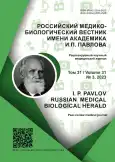Analysis of In-Hospital Mortality of Patients with New Coronavirus Infection (COVID-19) of Clinical Centre of Sechenov University
- Authors: Fomin V.V.1, Royuk V.V.1, Reshetnikov V.A.1, Volkova O.S.1, Korshever N.G.2, Kozlov V.V.3
-
Affiliations:
- I. M. Sechenov First Moscow State Medical University (Sechenov University)
- Saratov State Medical University named after V. I. Razumovsky
- Azerbaijan Medical University
- Issue: Vol 31, No 3 (2023)
- Pages: 381-389
- Section: Original study
- URL: https://bakhtiniada.ru/pavlovj/article/view/252554
- DOI: https://doi.org/10.17816/PAVLOVJ569334
- ID: 252554
Cite item
Abstract
INTRODUCTION: The epidemic of a new coronavirus infection (COVID-19) required a restructure of the entire healthcare system of the Russian Federation within a limited period of time. Here, the mortality of patients is the most important effective parameter that reflects successfulness of organization measures for improvement of the activity of medical institutions. The initial preparedness of the infrastructure permitted to rapidly deploy a hospital on the base of the Clinical Centre of Sechenov University for providing medical assistance to patients with COVID-19.
AIM: To analyze the in-hospital mortality of patients with COVID-19 at the Clinical Center of Sechenov University.
MATERIALS AND METHODS: The COVID-19 database (n = 19 230) of the Clinical Centre of Sechenov University for 2020–2022 was analyzed.
RESULTS: The overall in-hospital mortality in COVID-19 hospitals of the Clinical Centre of Sechenov University was 8.5%, which is the lower level compared to the data of foreign studies (Italy, Spain, Great Britain, USA, Iran). The main predictors of mortality are: basic — male gender, age (mainly > 75 years); existence of malignant neoplasms, diseases of the nervous system, diseases of the cardiovascular system, diseases of the endocrine system in patients; diseases occurring in the course of hospital treatment — artificial lung ventilation, past surgical interventions.
CONCLUSION: The working experience of the Clinical Center of Sechenov University shows a possibility for quick salvation of organizational tasks facing the healthcare system in the period of COVID-19 pandemic, with the results characterized by low lethality of hospitalized patients.
Full Text
##article.viewOnOriginalSite##About the authors
Viktor V. Fomin
I. M. Sechenov First Moscow State Medical University (Sechenov University)
Email: fomin_v_v_1@staff.sechenov.ru
ORCID iD: 0000-0002-2682-4417
SPIN-code: 8465-2747
MD, Dr. Sci. (Med.), Professor
Russian Federation, MoscowValeriy V. Royuk
I. M. Sechenov First Moscow State Medical University (Sechenov University)
Email: vvroyuk@mail.ru
ORCID iD: 0000-0002-4966-3767
SPIN-code: 7535-4008
MD, Cand. Sci. (Med.), Associate Professor
Russian Federation, MoscowVladimir A. Reshetnikov
I. M. Sechenov First Moscow State Medical University (Sechenov University)
Email: resh1960@mail.ru
ORCID iD: 0000-0002-7853-7356
SPIN-code: 4016-2059
MD, Dr. Sci. (Med.), Professor
Russian Federation, MoscowOl’ga S. Volkova
I. M. Sechenov First Moscow State Medical University (Sechenov University)
Email: volkova_o_s@staff.sechenov.ru
ORCID iD: 0000-0002-4568-1298
SPIN-code: 1758-1266
MD, Cand. Sci. (Med.)
Russian Federation, MoscowNatan G. Korshever
Saratov State Medical University named after V. I. Razumovsky
Email: korshever@bk.ru
ORCID iD: 0000-0002-5545-6844
SPIN-code: 3665-2116
MD, Dr. Sci. (Med.), Professor
Russian Federation, SaratovVasiliy V. Kozlov
Azerbaijan Medical University
Author for correspondence.
Email: kvv.doc@gmfil.com
ORCID iD: 0000-0002-2389-3820
SPIN-code: 7703-0013
MD, Cand. Sci. (Med.), Associate Professor
Azerbaijan, BakuReferences
- Glybochko PV, Svistunov AA, Fomin VV, et al. Rol’ klinik Sechenovskogo Universiteta v okazanii pomoshchi patsiyentam s novoy koronavirusnoy infektsiyey (COVID-19). National Health Care (Russia). 2020;1(1):23–7. (In Russ).
- Glybochko PV, Fomin VV, Moiseev SV, et al. Risk factors for the early develop- ment of septic shock in patients with severe COVID-19. Therapeutic Archive. 2020;92(11):17–23. (In Russ). doi: 10.26442/00403660.2020.11.000780
- Nikitin IG, Melekhov AV, Sayfullin MA, et al. Organizing the medical care for the COVID-19 patients in non-infectiousMoscow hospital: reassignment experience. Therapeutic Archive. 2020;92(11):31–7. (In Russ). doi: 10.26442/00403660.2020.11.000838
- Order of the Ministry of Health of the Russian Federation dated on 19 March, 2020 No. 198n «O vremennom poryadke organizatsii raboty meditsinskikh organizatsiy v tselyakh realizatsii mer po profilaktike i snizheniyu riskov rasprostraneniya novoy koronavirusnoy infektsii COVID-19». Available at: https://docs.cntd.ru/document/564482310. Accessed: 2023 August 31. (In Russ).
- Guskova ON, Dominikan IE, Volodko SN. Mortality, hospital mortality statistics and tanatological analysis of lethal outcomes in patients with new coronavirus infection (COVID-19) in Tver region. Verkhnevolzhskiy Meditsinskiy Zhurnal. 2021;20(4):8–13. (In Russ).
- Zhou F, Yu T, Du R, et al. Clinical course and risk factors for mortality of adult inpatients with COVID-19 in Wuhan, China: a retrospective cohort study. Lancet. 2020;395(10229):1054–62. doi: 10.1016/S0140-6736(20)30566-3
- Kuzovlev АN, Ermokhina LV, Melnikova NS, et al. A nomogram for predicting hospital mortality in patients with COVID-19 admitted to the intensive care unit. Messenger of Anesthesiology and Resuscitation. 2022;19(1):6–17. (In Russ). doi: 10.21292/2078-5658-2022-19-1-6-17
- Mokrysheva NG, Shestakova MV, Vikulova OK, et al. Analysis of risk factors for COVID-19-related fatal outcome in 337991 patients with type 1 and type 2 diabetes mellitus in 2020–2022 years: Russian nationwide retrospective study. Diabetes Mellitus. 2022; 25(5): 404–17. (In Russ). doi: 10.14341/DM12954
- Mityakov SN. Justification of factors influencing at the level of mortality from COVID-19. Razvitiye i Bezopasnost’. 2021;(4):4–18. (In Russ). doi: 10.46960/2713-2633_2021_4_4
- Sagatkali AS, Tusupkaliyeva KSh, Urazayeva ST, et al. Analysis of morbidity and risk factors for mortality from COVID-19 (literature review). West Kazakhstan Medical Journal. 2022;64(1):9–17. (In Russ). doi: 10.24412/2707-6180-2022-64-9-17
- Ssentongo P, Rastad H, Karim H, et al. Association of cardiovascular disease and 10 other pre-existing comorbidities with COVID-19 mortality: A systematic review and meta-analysis. PLoS One. 2020;15(8):e0238215. doi: 10.1186/s13098-020-00565-9
- Lai X, Wang M, Qin C, et al. Coronavirus Disease 2019 (COVID-2019) Infection Among Health Care Workers and Implications for Prevention Measures in a Tertiary Hospital in Wuhan, China. JAMA Netw Open. 2020;3(5):e209666. doi: 10.1001/jamanetworkopen.2020.9666
- Lee LY, Cazier J–B, Angelis V, et al. COVID-19 mortality in patients with cancer on chemotherapy or other anticancer treatments: a prospective cohort study. Lancet. 2020;395(10241):1919-26. doi: 10.1016/S0140-6736(20)31173-9
- Wu Z, McGoogan JM. Characteristics of and important lessons from the coronavirus disease 2019 (COVID-19) outbreak in China: summary of a report of 72314 cases from the Chinese Center for Disease Control and Prevention. JAMA. 2020;323(13):1239–42. doi: 10.1001/jama.2020.2648
Supplementary files








